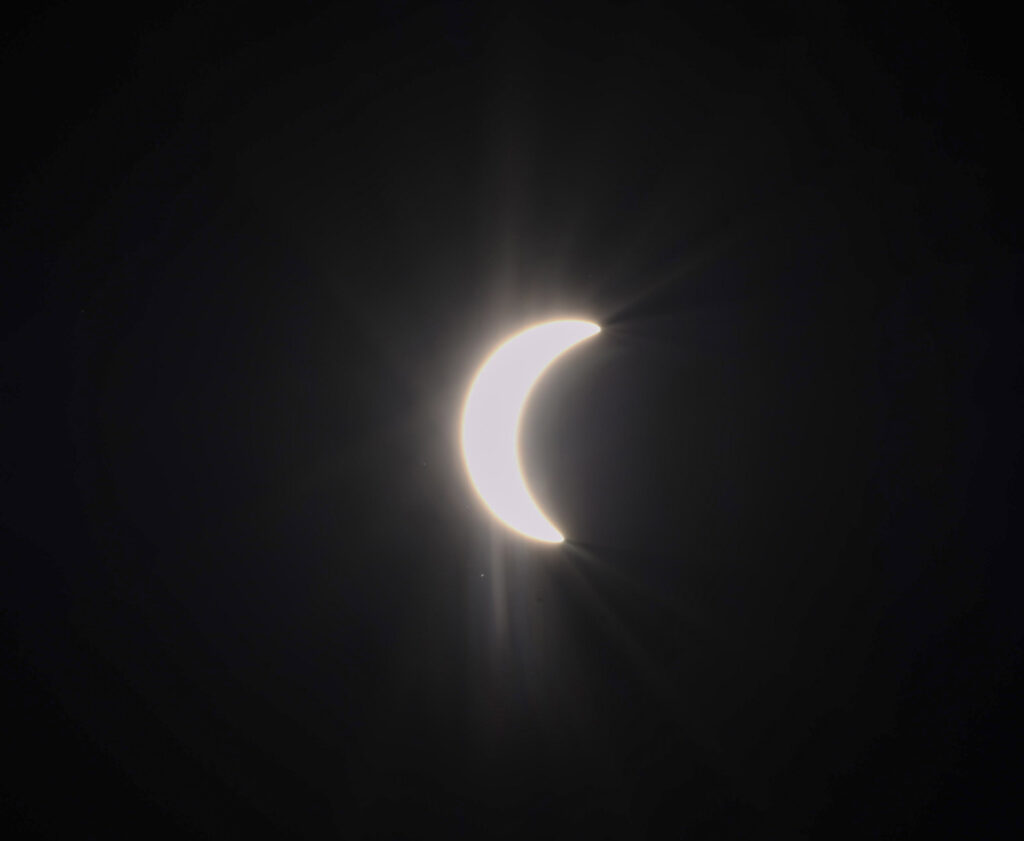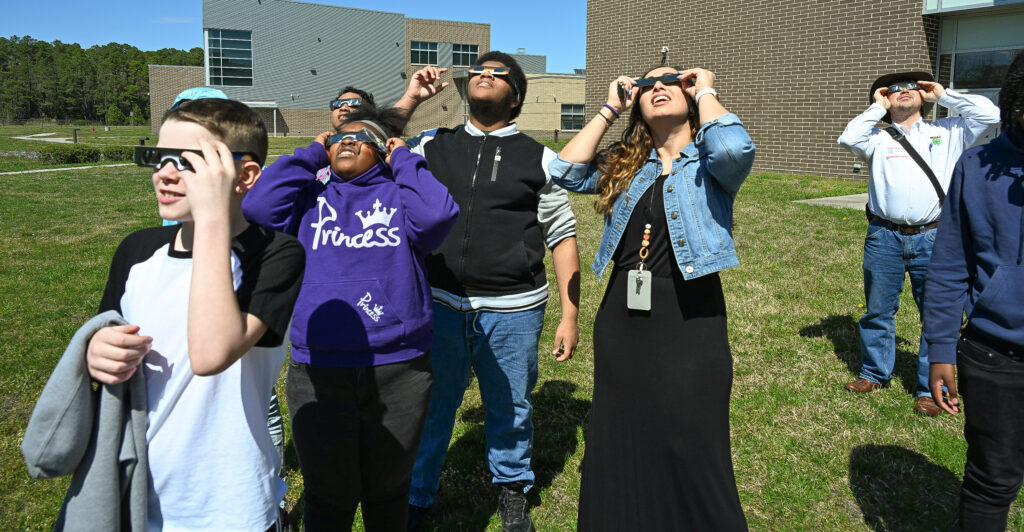
People across the nation hunted for special viewing glasses, created pinhole projectors, planned parties and flocked to areas of totality in anticipation of the Great North American Eclipse and getting the most from the rare occurrence. The April 8 celestial event promised the first opportunity since 2017 and the last until August 23, 2044, to witness such a sight.
“The solar eclipse provided a unique chance for youth in our community to learn about the sun, the moon and the science behind the phenomenon,” said Ariel Clay, UMES Extension 4-H STEM’s youth development specialist.

UMES 4-H educators delivered more than 20 free eclipse kits to schools in Wicomico, Worcester and Somerset counties, Clay said. The kits contained viewing glasses and materials to complete experiential learning as part of a heliophysics (the study of the sun and its influence on the solar system) curriculum designed by NASA and the University of Maryland Extension 4-H. The educational program, 4-H + NASA Helio Club, consisted of lesson plans and hands-on activities across various age levels geared toward understanding the electromagnetic spectrum, the layers of the sun and magnetic fields, among other interesting astrological topics.
“Dozens of area educators used the kits to teach some 2,360 students the science behind the eclipse and to facilitate safe viewing of the actual event — around 83% on the Lower Eastern Shore,” Clay said. In addition, UMES Extension 4-H educators conducted on-site visits to Wicomico and Bennett middle schools, James M. Bennett High School, Somerset Intermediate, to facilitate activities and answer questions.
Pictured, from left, Bennett Middle School students Michael Bratten, Niandrea Riley and Ja’Kil Ayala view the eclipse safely with their teacher Salpeas and UMES Extension 4-H Educator Jeremiah Mowen. (Photos by Todd Dudek, UMES Agricultural Communications).
ACTIVITIES
Solar System Scale — If the sun were shrunk to the size of a soccer ball, the Earth would be the size of a head of a pin and would be about 26 yards away. That’s a little over a quarter of a football field! To scale images of the sun and Earth were provided in each kit, and the students were asked to estimate how far away the two would be. This activity helps one grasp the scale of the universe around us.
Electromagnetic Scale and UV Bead Bookmark — The sun’s energy travels in the form of waves, with the longest wavelengths being about a thousand meters and the shortest being less than the width of a single atom. Humans perceive a small portion of that wavelength spectrum as visible light. The shorter the wavelength, the more harmful it is to organic life. Fortunately, our atmosphere protects us from most of these harmful wavelengths. A small amount of ultraviolet light does make it through, which can cause sunburn or damage our eyes over time, if we are not careful to protect our skin and eyes. In this activity, students made a bookmark with an image depicting the electromagnetic spectrum. UV-sensitive beads were placed on the tassel. Exposing the bookmark to various forms of light demonstrated if UV waves were present by the beads changing color.
Make Your Own Spectroscope — When wavelengths in the visible light spectrum pass through specific materials, such as a crystal prism or a rain drop, the waves bend at varying degrees. This separates the waves into distinct bands, which we experience as a rainbow. Students made a simple spectroscope out of cardstock and a special plastic film called a diffraction grid. When the spectroscope is held to a light source, youth can see a highly defined rainbow through its viewfinder.
Eclipse Chalk Art — When the moon fully eclipses the sun, a fiery ring around the edge, the corona, can still be seen. The very edge of the sun’s atmosphere is very dynamic, constantly changing shape due to solar flares and shifts in the magnetic field. Elementary school children modeled the appearance of the corona using chalk, a white paper circle representing the sun and a black paper circle representing the eclipsing moon.
Gravity Slingshot Engineering Challenge — Every celestial object creates a gravity field, with more massive objects creating more powerful gravity fields. When a small object, such as a NASA probe, passes near a large gravity field, like Jupiter, it is pulled by that force. If the small object has enough momentum, then the gravitational pull will not be enough to make it crash into the planet. Instead, its path will bend toward the planet and it will slingshot past it. Since energy is never destroyed, only converted, the force applied to the probe will be transformed into more momentum, causing the probe to move faster. Middle and high school students modeled these gravitational effects by rolling metal ball bearings at various speeds and trajectories past strong magnets.
Pinhole Projectors — To see the eclipse without directly viewing it, the image of the shadow can be projected onto the ground with a simple pinhole projector. Cut a hole in a piece of cardstock, tape a piece of aluminum foil over the hole, then poke a tiny hole in the aluminum with a pin. When the projector is held at the waist, the ray of sun passing through the pinhole will display how much of the sun is eclipsed by the moon at that moment. Youth were provided with materials to make their own projectors either in class or at home.
Eclipse Observation Sheets — Worksheets were provided for youth to record their observations about the weather conditions and appearance of the eclipse. They could either use the eclipse viewing glasses provided or the pinhole projectors they constructed.
Gail Stephens, agricultural communications and media associate, University of Maryland Eastern Shore, School of Agricultural and Natural Sciences, UMES Extension, gcstephens@umes.edu, 410-621-3850.
Photos by Todd Dudek, agricultural communications, University of Maryland Eastern Shore, School of Agricultural and Natural Sciences, UMES Extension, tudek@umes.edu.

